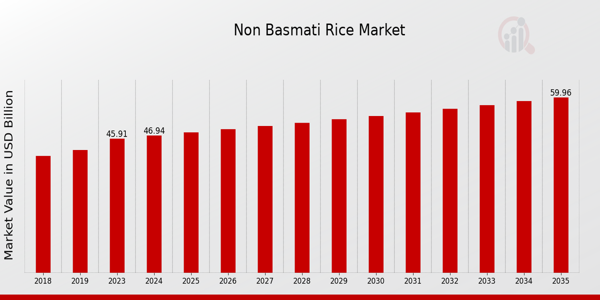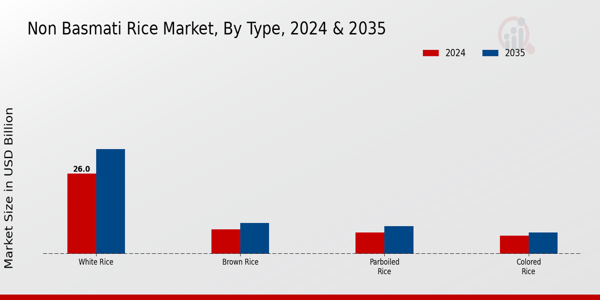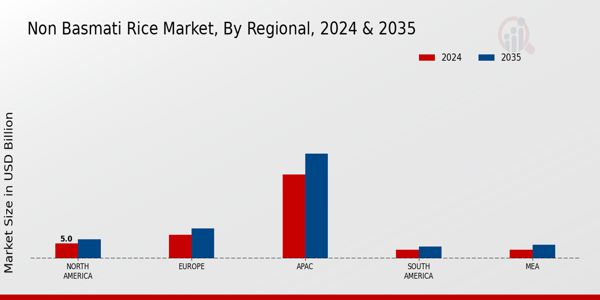Global Non-Basmati Rice Market Overview
As per MRFR analysis, the Non-Basmati Rice Market Size was estimated at 45.91 (USD Billion) in 2023. The Non-Basmati Rice Market Industry is expected to grow from 46.94(USD Billion) in 2024 to 60.0 (USD Billion) by 2035. The Non-Basmati Rice Market CAGR (growth rate) is expected to be around 2.25% during the forecast period (2025 - 2035).
Key Non-Basmati Rice Market Trends Highlighted
The Non Basmati Rice Marketis witnessing several significant trends driven by various factors. Rising global population and increasing income levels are leading to higher demand for rice as a staple food across many regions. Additionally, changing dietary preferences, with consumers leaning toward more rice varieties, are contributing to this growth. The expansion of e-commerce and online grocery platforms has made it easier for consumers to access different types of non-Basmati rice, further fueling market growth. Moreover, government support for agricultural practices and initiatives to improve rice production are also playing a role in market dynamics.
There is potential for producers to exploit, growing interest for organic and specialty rice varieties means untapped markets for them. More people watch what they eat, and as a result, people are more aware of gluten-free products and are ready to change to rice. The trend towards using rice as an ingredient in processed foods by manufacturers is also an interesting vector that may be further developed — the manufacturers are looking to widen the range of their products with these ingredients. Additionally, innovation, such as branding and packaging can be used to create new products and to reach more customers than before. Recently, the trend towards sustainability and ecologically friendly agriculture has gained traction, thus forcing producers to use less harmful methods.
Consumers are conscious of the clippings in many crops, which rice does not have, hence the shift towards rice mainly grown without too many chemicals. Technology is also changing the picture with things like precision agriculture and better methods of irrigation boosting yields. In summary, the Non Basmati Rice Marketis fuelling the revolution and adapting to the changes in its consumers, technology advancements and regulations.

Non-Basmati Rice Market Drivers
Rising Global Population and Increasing Demand for Staple Foods
The Non Basmati Rice Marketindustry is significantly influenced by the rising global population, which is projected to reach nearly 9.7 billion by 2050. As populations grow, there is a direct increase in the demand for staple foods, with rice being a primary source of calories for millions of people across various regions. Non-Basmati rice is particularly favored in many developing nations due to its affordability and accessibility. As urbanization continues and lifestyles change, the need for convenient, ready-to-cook food options has risen, further propelling the demand for non-Basmati rice varieties.
The trend toward vegetarianism and plant-based diets is also contributing to rice consumption, as individuals seek alternative grains that can provide the necessary carbohydrates and nutrition without meat. Moreover, the emerging middle class in developing countries is creating a surge in purchasing power, leading consumers to seek higher quality and diverse food products, thereby propelling growth in the Global Non-Basmati Rice Market. This increasing consumption pattern, shaped by health consciousness and dietary preferences, solidifies non-Basmati rice as a crucial staple in many regions, ensuring its pivotal role in the food supply chain.
Together, these elements create a dynamic environment that fosters growth and expansion in this market, ensuring that non-Basmati rice remains a fundamental component of global food security and economic stability.
Growth of the Food Processing Industry
The expansion of the food processing industry is a major driver of the Non Basmati Rice Market. With increasing industrialization, there is a growing demand for processed food products, which often incorporate rice as a key ingredient. This sector continues to evolve with innovations in food technology, leading to the development of new rice-based products, including snacks, instant meals, and ready-to-cook items. As food processors seek to improve tastes and nutritional profiles, the demand for diverse non-Basmati rice varieties is expected to surge, particularly in urban areas where busy lifestyles fuel the need for convenient meal options.
Government Initiatives and Support for Rice Cultivation
Governments around the world play a crucial role in supporting rice cultivation through several initiatives, including subsidies, research funding, and agricultural training programs. Such support not only helps stabilize rice production but also encourages farmers to adopt modern farming techniques, improve productivity, and enhance the quality of non-Basmati rice. This, in turn, boosts the overall supply in the market, meeting increasing consumer demands and ensuring food security.
Non-Basmati Rice Market Segment Insights
Non-Basmati Rice Market Type Insights
The Non Basmati Rice Marketencompasses various types that cater to diverse consumer preferences and culinary traditions, with substantial revenue generation. In 2024, the market was poised to secure a valuation of 46.94 USD Billion, with White Rice leading as a dominant force, accounting for a significant value of 26.0 USD Billion, reflecting its widespread popularity and consumption in numerous cuisines. This type is primarily favored due to its versatile use in everyday meals across multiple demographics, establishing itself as a staple in households.
Following White Rice, the Brown Rice segment holds a notable share, valued at 8.0 USD Billion in 2024. Its increasing acceptance as a healthier option, thanks to its whole grain properties and nutritional benefits, positions it as a key player in the market. The Parboiled Rice segment contributes an additional 7.0 USD Billion to the market. Its unique processing method enhances the nutritional value and preserves the flavor of the rice, making it a preferred choice for many consumers seeking convenience without losing health benefits. Lastly, Colored Rice, valued at 5.94 USD Billion in 2024, caters to niche markets that appreciate its distinct varieties and aesthetic appeal, often used in specialty dishes and celebrations.
These insights highlight the Global Non-Basmati Rice Market's segmentation, showcasing how each type plays a vital role in catering to consumer needs driven by preferences for taste, health, and cultural significance. Overall, these market statistics offer a clear view of the dynamics at play, elucidating the growth prospects and competitive landscape within the rice industry.

Non-Basmati Rice Market Application Insights
The Non Basmati Rice Marketis projected to achieve a valuation of 46.94 billion USD by 2024, highlighting its significant growth trajectory. Within this market, the application segment plays a crucial role, encompassing areas such as household consumption, food service, and food processing. Each application contributes uniquely, with household consumption being one of the major components, driven by rising populations and changing dietary preferences. The food service segment is essential as it serves restaurants and catering, reflecting the growing trend in dining out and food delivery.
Food processing also holds prominence due to its demand in creating ready-to-eat meals and other processed food products. The Non Basmati Rice Marketrevenue showcases diversification within these applications as consumer lifestyles evolve towards convenience and healthy eating. Overall, the market growth in these applications stems from increasing urbanization, coupled with a preference for diverse rice varieties, creating favorable opportunities for businesses in this sector. The Non Basmati Rice Marketstatistics indicate that these applications collectively reflect the trends and shifting dynamics, demonstrating their significance in overall market expansion.
Non-Basmati Rice Market Grain Length Insights
The Non Basmati Rice Market, valued at 46.94 USD Billion in 2024, comprises various segments based on Grain Length, which includes short grain, medium grain, and long grain varieties. Each grain length brings distinct characteristics influencing consumer preferences and culinary applications. The short grain variety, known for its sticky texture, caters to cuisines where clumping is desirable, thus holding a notable position in the market. Conversely, medium-grain rice is widely appreciated for its versatility and balanced texture, making it a staple in various dishes.
Long-grain rice, with its separate and fluffy grains, is favored for its aesthetic appeal and is integral in many international cuisines, often dominating consumer choices. The diversity in the Grain Length segment contributes to the overall dynamics of the Global Non-Basmati Rice Market, with unique attributes driving demand across different regions. Understanding these trends is essential for stakeholders aiming to capture the evolving market growth and emerging opportunities while also addressing potential challenges related to agricultural practices and supply chain efficiencies.
Additionally, the ever-increasing demand for rice globally further bolsters the relevance of this segment in market strategies.
Non-Basmati Rice Market Quality Insights
The Non Basmati Rice Marketrevenue related to the Quality segment is poised for growth as the total market reaches a valuation of 46.94 billion USD by 2024. This segment is broadly categorized into Premium, Standard, and Economy levels, catering to diverse consumer preferences and budgets. The Premium category often showcases higher-quality grains and is increasingly popular among health-conscious consumers seeking nutritional value, thus highlighting its importance in driving market growth. Meanwhile, the Standard category represents a substantial share of the market, appealing to daily consumers looking for a balance between quality and affordability.
Economy rice, on the other hand, has a significant presence, especially in budget-centric markets, contributing to the overall market dynamics. This diversification within the Non Basmati Rice Marketsegmentation allows for better targeting and meeting various consumer needs. With a steady demand and consumer inclination towards value-for-money products, the market is expected to thrive in the coming years, supported by factors such as increasing population and changing dietary patterns. However, challenges like fluctuating production costs and quality control can impact growth.
Maintaining a balance between quality and affordability will be crucial for players operating in this segment.
Non-Basmati Rice Market Regional Insights
The Non Basmati Rice Marketrevenue showcases significant regional variances, with the APAC region holding a majority share at a value of 28.0 USD Billion in 2024, underscoring its dominance in the production and consumption of non-basmati rice. Following APAC, Europe is positioned as a significant player, valued at 8.0 USD Billion in the same year, driven by strong culinary traditions and a growing demand for rice products. North America, contributing 5.0 USD Billion, reflects a steady interest in non-basmati varieties, catering to diverse consumer preferences.
Meanwhile, South America and MEA are smaller markets, valued at 3.0 USD Billion and 2.94 USD Billion, respectively, yet they represent opportunities for growth due to increasing food diversification and agricultural investments in these regions. The Non Basmati Rice MarketStatistics indicate a robust market potential across all regions, influenced by evolving dietary patterns and trade dynamics that push for market growth. Each region presents unique challenges and opportunities, including distribution logistics and consumer awareness, shaping the competitive landscape of the Non Basmati Rice Marketindustry.
The segmentation within this market reflects a diverse consumer base that drives specific trends and innovations tailored to local tastes and needs, enhancing overall engagement with non-basmati rice products.

Non-Basmati Rice Market Key Players and Competitive Insights:
The Non Basmati Rice Marketis characterized by a diverse array of players striving to carve out a significant presence in an international landscape that primarily caters to the varying culinary preferences of consumers. The competition is fierce, fueled by increasing demand for non-basmati rice varieties in both domestic and global markets. As producers focus on enhancing quality, yield, and distribution capabilities, innovation in processing methods and sustainability practices has also become a key differentiator among competitors. The market dynamics are influenced by shifts in consumer preferences, pricing strategies, and regional production capacities, necessitating a strategic approach for companies to thrive in this bustling sector.
Agro Products and Agencies operates as a noteworthy player in the Global Non-Basmati Rice Market, distinguished by its extensive network and strong market presence. The company has developed robust supply chain mechanisms that ensure efficient distribution and timely delivery, enhancing its competitive edge. With a commitment to quality, Agro Products and Agencies have established strong relationships with farmers and suppliers, enabling them to offer a diverse range of non-basmati rice varieties that cater to the preferences of a wide customer base. The strengths of Agro Products and Agencies lie in their ability to adapt to changing market conditions, maintain stringent quality control standards, and leverage technology to streamline operational efficiency, all of which contribute to solidifying their market position.
Jiangsu Kwanon Food Co. has garnered recognition in the Non Basmati Rice Marketfor its innovative approaches and commitment to sustainability. The company has invested significantly in researching and developing rice cultivation techniques that emphasize environmental responsibility without compromising quality. Jiangsu Kwanon Food Co's strengths include a well-established distribution network that facilitates quick access to markets and the ability to tailor products to meet the evolving preferences of consumers. Additionally, the company's focus on customer satisfaction and quality assurance has led to a loyal customer base, further solidifying its reputation in the non-basmati segment of the rice market. By continuously exploring opportunities for growth and expanding its product offerings, Jiangsu Kwanon Food Co. remains a formidable competitor in this vibrant industry.
Key Companies in the Non-Basmati Rice Market Include:
- Agro Products and Agencies
- Jiangsu Kwanon Food Co
- Sun Agro
- Olam Group
- Cargill
- Siam City Cement Public Company
- Maharashtra State Cooperative Cotton Growers Marketing Federation
- LGH Group
- Panama Agro
- Golden Grain
- Manhattan Distributors
- Riceland Foods
- Tropic Gourmet
- Marubeni Corporation
Non-Basmati Rice Market Industry Developments
The Non Basmati Rice Markethas recently witnessed significant developments, reflecting shifts in trading dynamics and market demands. Companies such as Olam Group and Cargill have been focusing on enhancing their product offerings and expanding their logistics capabilities to meet rising consumer demand. Agro Products and Agencies, as well as Jiangsu Kwanon Food Co, have reported growth in their export volumes, fueling competition in various regions. Recent trends suggest that demand from Southeast Asian countries is on the rise, impacting pricing strategies among major players like Sun Agro and Golden Grain in response to fluctuating supply chains. The focus on sustainable practices is also gaining traction, with companies like LGH Group and Tropic Gourmet exploring eco-friendly production methods. Although merger and acquisition activities have been limited recently within the sector, companies are continually aligning their strategies to bolster market position. Notably, the Maharashtra State Cooperative Cotton Growers Marketing Federation has been engaged in collaborations to strengthen its supply chain, thereby potentially increasing market valuation. The overall growth trajectory in this market sector indicates a robust demand that could reshape future pricing and investment strategies among key players.
Non-Basmati Rice Market Segmentation Insights
| Report Attribute/Metric |
Details |
| Market Size 2023 |
45.91(USD Billion) |
| Market Size 2024 |
46.94(USD Billion) |
| Market Size 2035 |
60.0(USD Billion) |
| Compound Annual Growth Rate (CAGR) |
2.25% (2025 - 2035) |
| Report Coverage |
Revenue Forecast, Competitive Landscape, Growth Factors, and Trends |
| Base Year |
2024 |
| Market Forecast Period |
2025 - 2035 |
| Historical Data |
2019 - 2023 |
| Market Forecast Units |
USD Billion |
| Key Companies Profiled |
Agro Products and Agencies, Jiangsu Kwanon Food Co, Sun Agro, Olam Group, Cargill, Siam City Cement Public Company, Maharashtra State Cooperative Cotton Growers Marketing Federation, LGH Group, Panama Agro, Golden Grain, Manhattan Distributors, Riceland Foods, Tropic Gourmet, Marubeni Corporation |
| Segments Covered |
Type, Application, Grain Length, Quality, Regional |
| Key Market Opportunities |
Rising population demand, Increasing health consciousness, Export potential in emerging markets, Innovative rice product offerings, Growing preference for organic rice |
| Key Market Dynamics |
increasing demand for affordable rice, diverse culinary applications, favorable climatic conditions, government support and subsidies, rising population and food security concerns |
| Countries Covered |
North America, Europe, APAC, South America, MEA |
Frequently Asked Questions (FAQ) :
The Non Basmati Rice Marketis expected to reach a value of 60.0 USD Billion by 2035.
In 2024, the Non Basmati Rice Marketwas valued at 46.94 USD Billion.
The expected CAGR for the Non Basmati Rice Marketfrom 2025 to 2035 is 2.25%.
The Asia-Pacific (APAC) region is expected to dominate the Non Basmati Rice Marketwith a valuation of 28.0 USD Billion in 2024.
White Rice is expected to be valued at 26.0 USD Billion in the Non Basmati Rice Marketin 2024.
Key players in the Non Basmati Rice Marketinclude Agro Products and Agencies, Olam Group, and Cargill.
By 2035, the value of Brown Rice in the Non Basmati Rice Marketis expected to reach 10.0 USD Billion.
The projected value of the Non Basmati Rice Marketin Europe for 2035 is 10.1 USD Billion.
Challenges influencing growth include fluctuating production rates and competition from imported rice varieties.

















